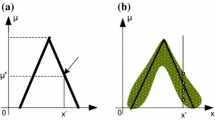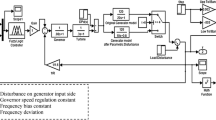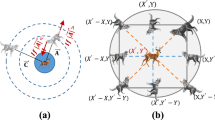Abstract
In this paper we propose the use of a hybrid PSO-GA optimization method for automatic design of fuzzy logic controllers (FLC) to minimize the steady state error of a plant’s response. We test the optimal FLC obtained by the hybrid PSO-GA method using benchmark control plants. The bio-inspired and the evolutionary methods are used to find the parameters of the membership functions of the FLC to obtain the optimal controller. Simulation results are obtained to show the feasibility of the proposed approach. A comparison is also made among the proposed Hybrid PSO-GA, GA and PSO to determine if there is a significant difference in the results.













Similar content being viewed by others
References
Abd-El-Wahed WF, Mousa AA, El-Shorbagy MA (2011) Integrating particle swarm optimization with genetic algorithms for solving nonlinear optimization problems. J Comput Appl Math 235(5):1446–1453
Alcalá R, Alcalá-Fdez J, Herrera F (2007) A proposal for the genetic lateral tuning of linguistic fuzzy systems and its interaction with rule selection. IEEE Trans Fuzzy Syst 15(4):616–635
Alcalá R, Gacto MJ, Herrera F, Alcalá-Fdez J (2007) A multi-objective genetic algorithm for tuning and rule selection to obtain accurate and compact linguistic fuzzy rule-based systems. Int J Uncert Fuzziness Knowl Based Syst 15(5):539–557
Angeline PJ (1998) Evolutionary optimization versus particle swarm optimization: philosophy and performance differences. Evolutionary programming VII, Lecture Notes in Computer Science 1447, Springer, pp 601–610
Angeline PJ (1998) Using selection to improve particle swarm optimization. In: Proceedings 1998 IEEE world congress on computational intelligence, Anchorage, Alaska, IEEE, pp 84–89
Casillas J, Cordon O, del Jesús MJ, Herrera F (2005) Genetic tuning of fuzzy rule deep structures preserving interpretability and its interaction with fuzzy rule set reduction. IEEE Trans Fuzzy Syst 13(1):13–29
Chi Z, Yan H, Pham T (1996) Fuzzy algorithms: with applications to image processing and pattern recognition. World Scientific, Singapore
Cordon O, Gomide F, Herrera F, Hoffmann F, Magdalena L (2004) Ten years of genetic fuzzy systems: current framework and new trends. Fuzzy Sets Syst 141(1):5–31
Driankov D, Hellendoorn H, Reinfrank M (1993) An introduction to fuzzy control. Springer, Berlin
Engelbretht AP (2005) Fundamentals of computational swarm intelligence, England, Wiley, pp 5–129
Eberhart RC, Kennedy J (1995) A new optimizer using particle swarm theory. In: Proceedings of the sixth international symposium on micromachine and human science, Nagoya, Japan, pp 39–43
Fogel DB (1994) An introduction to simulated evolutionary optimization. IEEE Trans Neural Netw 5(1):3–14
Fukao T, Nakagawa H, Adachi N (2000) Adaptive tracking control of a nonholonomic mobile robot. IEEE Trans Robotics Automat 16(5):609–615
Kao Y-T, Zahara E (2008) Hybrid genetic algorithm and particle swarm optimization for multimodal functions. Appl Soft Comput 8(2):849–857
Kennedy J, Mendes R (2002) The particle swarm-explosion, stability, and convergence in a multidimensional complex space. IEEE Trans Evol Comput 6(1):58–73
Kennedy J, Mendes R (2002) Population structure and particle swarm performance. Proceedings of IEEE conference on evolutionary computation, In, pp 1671–1676
Kim DH (2011) Hybrid GA–BF based intelligent PID controller tuning for AVR system. Appl Soft Comput 11(1):11–22
Lee TH, Leung FHF, Tam PKS (1999) Position control for wheeled mobile robot using a fuzzy controller. IEEE, Los Alamitos, pp 525–528
Liang Q, Mendel JM (2000) Interval Type-2 fuzzy logic systems: theory and design. IEEE Trans Fuzzy Syst 8(5):535–550
Martinez R, Castillo O, Aguilar LT (2008) Intelligent control for a perturbed autonomous wheeled mobile robot using Type-2 fuzzy logic and genetic algorithms. J Automat Mobile Robotics Intell Syst 2:1–10
Martínez R, Castillo O, Aguilar LT, Rodríguez A (2009) Optimization of Type-2 fuzzy logic controllers for mobile robots using evolutionary methods. In: Proceedings of the 2009 IEEE international conference on systems, man, and cybernetics, San Antonio, TX, USA, pp 4909–4914
Marinakis Y, Marinaki M (2010) A hybrid genetic: particle swarm optimization algorithm for the vehicle routing problem. Expert Syst Appl 37(2):1446–1455
Melin P, Castillo O (2004) A new method for adaptive control of non-linear plants using Type-2 fuzzy logic and neural networks. Int J General Syst 33(2): 289–304, 1563–5104
Montiel O, Castillo O, Melin P, Sepúlveda R (2005) Black box evolutionary mathematical modeling applied to linear systems. Int J Intell Syst 20(2):293–311
Montiel O, Castillo O, Melin P, Díaz AR, Sepúlveda R (2007) Human evolutionary model: a new approach to optimization. Inform Sci 177(10):2075–2098
Montiel O, Sepulveda R, Melin P, Castillo O, Porta Garcia MA, Meza Sanchez IM (2008) Performance of a simple tuned fuzzy controller and PID controller on a DC motor. In: Foundations of computational intelligence, IEEE symposium series on computational intelligence (FOCI’07), Honolulu, Hawai, USA, pp 531–537, April 1–5
Muhammad S, Saira Z, Muddassar F (2009) A hybrid GA-PSO fuzzy system for user identification on smartphones, GECCO’09. In: Proceedings of the 11th annual conference on genetic and evolutionary computation, Montreal-Canada, pp 1617–1624, July 8–12
Niu Q, Jiao B, Gu X (2008) Particle swarm optimization combined with genetic operators for job shop scheduling problem with fuzzy processing time. Appl Math Comput 205(1):148–158
Pedrycz W (1996) Fuzzy modelling: paradigms and practice. Kluwer Academic Press, Dordrecht
Sepúlveda R, Montiel O, Castillo O, Melin P (2010) Optimizing the MFs in Type-2 fuzzy logic controllers, using the human evolutionary model. In: International review of automatic control (IREACO), theory and applications, volume 3, no. 1, Italy, pp 1–10
Tripathi PK, Bandyopadhyay S, Kumar Pal S (2007) Multi-Objective Particle Swarm Optimization with time variant inertia and acceleration coefficients. Inf Sci 177(22):5033–5049
Valdez F, Melin P, Castillo O (2011) An improved evolutionary method with fuzzy logic for combining particles swarm optimization and genetic algorithms. Appl Soft Comput Impact Soft Comput Progr Artif Intell 11(2):2625–2632
Herrera F (2008) Genetic fuzzy systems: taxonomy, current research trends and prospects. Evol Intel 1:27–46
Herrera F, Lozano M, Verdegay JL (1995) Tuning fuzzy logic controllers by genetic algorithms. Int J Approx Reason 12(3–4):299–315
Fazendeiro P, de Oliveira JV, Pedrycz W (2007) A Multiobjective design of a patient and anaesthetist-friendly neuromuscular blockade controller. IEEE Trans Biomed Eng 54(9):1667–1678
Lin Chih-Min, Li Ming-Chia, Ting Ang-Bung, Lin Ming-Hung (2011) A robust self-learning PID control system design for nonlinear systems using a particle swarm optimization algorithm. Int J Mach Learn Cybernet 2(4):225–234
Rana S, Jasola S, Kumar R (2012) A boundary restricted adaptive particle swarm optimization for data clustering. Int J Mach Learn Cybernet. doi:10.1007/s13042-012-0103-y
Wang Xizhao, He Yulin, Dong Lingcai, Zhao Huanyu (2011) Particle swarm optimization for determining fuzzy measures from data. Inform Sci 181(19):4230–4252
Author information
Authors and Affiliations
Corresponding author
Rights and permissions
About this article
Cite this article
Martínez-Soto, R., Castillo, O., Aguilar, L.T. et al. A hybrid optimization method with PSO and GA to automatically design Type-1 and Type-2 fuzzy logic controllers. Int. J. Mach. Learn. & Cyber. 6, 175–196 (2015). https://doi.org/10.1007/s13042-013-0170-8
Received:
Accepted:
Published:
Issue Date:
DOI: https://doi.org/10.1007/s13042-013-0170-8




